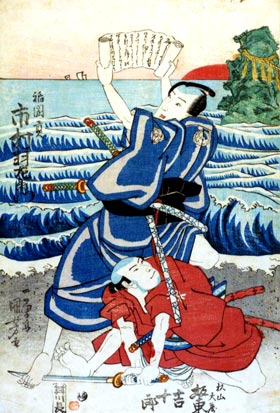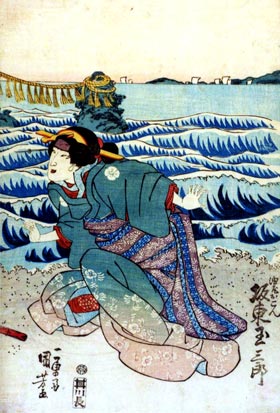| FUTAMI-GA-URA |
| Play title | Ise Ondo Koi no Netaba The Ise Dances and Love's Dull Blade* |
| Author | Chikamatsu Tokuz˘ Tatsuoka Mansaku Namiki Sh˘z˘ II |
| History |
The drama "Ise Ondo Koi no Netaba" was premiered in the 7th lunar month of 1796 in ďsaka, produced at the Kado no Shibai by the zamoto Fujikawa Hachiz˘ III [casting]. It was based on a real savage mass murder, which happened the same year in Ise. |
| Structure |
"Ise Ondo Koi no Netaba" is made up of 4 acts, divided in 7 scenes. "Futami-ga-Ura" is the last scene of the first act. It is rarely staged. |
| Key words |
Futami-ga-Ura Ise Ise Jingű Ise Ondo Meoto Iwa Sewamono |
| Summary |
Introduction The plot concerns a valuable sword made by the smith Shimosaka and possessed by a bloodthirsty spirit. The daimy˘ of Awa had in his service a samurai to whom he entrusted the precious Shimosaka sword. This sword caused the death of the samurai and also that of his son, who inherited the trust. The son left an only child, a little boy, whose mother was already dead. The boy's aunt, terrified of the evil sword, disposed of the weapon secretly and fled from Awa with her little nephew under an assumed name in the Ise district. The boy, Fukuoka Mitsugi (who is the hero of the play), was adopted by a priest of the Grand Shrines and grew up in the service of the Shrines, but he never forgot that his first allegiance was to the daimy˘ of Awa and more especially to the daimy˘'s Chief Counsellor, who had been his father's immediate superior. Meanwhile, the daimy˘ of Awa died and was succeeded by a child. This boy's uncle, Kajikawa Daigaku, plotted to usurp the power, but was thwarted in his plans by the loyalty of the Chief Counsellor. Daigaku therefore determined to discredit him and one of the several plots he devised concerned the Shimosaka sword. Word came to the Chief Counsellor that this sword, his lord's heirloom, was for sale in the town of Furuichi in Ise. He therefore sent his son, Imada Manjir˘, to buy it and bring it back to Awa. Manjir˘ was a charming youth of weak character. He bought the sword, but then fell victim to the attractions of Okishi, a courtesan of Furuichi. Instead of returning home he remained with his love and to pay his debts was forced to pawn the Shimosaka sword, although retaining the certificate which proved its authenticity. The spies of the wicked Daigaku were watching Manjir˘. The chief of these, a samurai named Tokushima Iwaji, plotted to secure both the sword and the certificate so that Manjir˘ would be unable to fulfil his mission and his father would be disgraced through him. Iwaji succeeded by a trick in stealing the certificate from Manjir˘, but could not lay his hands on the sword because both the pawnbroker and the weapon had disappeared. At this point Fukuoka Mitsugi enters the story. As has been said, he was by birth the retainer of the Chief Counsellor of Awa. He learned of Manjir˘'s predicament and received permission from his present master, who was a friend of Manjir˘'s father, to go to the youth's assistance. Mitsugi decided that the first thing was to get Manjir˘ out of harm's way; then he could hunt for the sword and the certificate. Act I, Scene 4: Futami-ga-Ura Mitsugi comes to the beach with Manjir˘ whom he is escorting to a place of safety. Mitsugi has already had a skirmish with Iwaji's spies in the course of which he has secured possession of a piece of valuable evidence, half of a letter from Daigaku to Iwaji, which proves conclusively that Daigaku is plotting against his nephew, the young daimy˘. The spies are on his track, but in the darkness the two parties run into each other unawares. There follows a general scrimmage of the sort greatly appreciated by Kabuki audiences. Both sides receive reinforcements in the shape of Mitsugi's servant Rinpei and another spy who have been carrying on a private fight. The spies are overwhelmed. Mitsugi wrests from one of them the other half of the torn letter which makes his evidence complete. He send Manjir˘ off in charge of Rinpei and then, holding down his struggling antagonists, waits for the sun to rise between the two rocks so that he may have light enough to make sure that he has obtained the right paper. The curtain is drawn as he poses triumphantly. Aubrey and Giovanna Halford in "The Kabuki Handbook" (*) the title "The Ise Dances and Love's Dull Blade" comes from the 2nd volume of "Kabuki Plays On Stage". |
 |
 |
|
The actors Ichimura Uzaemon XII (left print/top), Band˘ Kichijűr˘ (left print/bottom) and Band˘ Tamasabur˘ I (right print) playing the roles of Fukuoka Mitsugi, Sugiyama Daiz˘ and the courtesan Okon in the drama "Ise Ondo Koi no Netaba", which was staged in the 6th lunar month of 1833 at the Ichimuraza (print made by Utagawa Kuniyoshi) |
|
|
|
| Contact | Main | Top | Updates | Actors | Plays | Playwrights | Programs | Links | FAQ | Glossary | Chronology | Illustrations | Prints | Characters | Derivatives | Theaters | Coming soon | News |